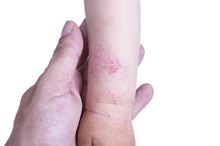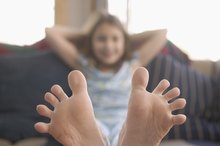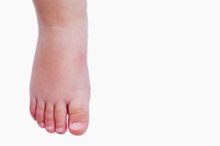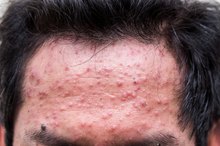Rash on the Back of a Child's Knees
Rashes are common in children but often leave parents puzzled -- especially when they occur in an odd place, like behind the knees. Atopic dermatitis and psoriasis are the most common causes 10. Contact dermatitis and heat rash are other possibilities. The appearance of the rash, the age of the child, recent illnesses or changes in environment, and family history are important clues for determining the cause. Once a diagnosis is made, the rash can be properly treated.
Atopic Dermatitis
Atopic dermatitis is the most likely cause of a rash that develops behind a child's knees. This long-term skin condition occurs due to inflammation in the skin that leads to extreme itchiness, which can be so severe that the child may have trouble sleeping. The rash is dry, red and bumpy, and tends to come and go. An estimated 12 percent of children in the U.S. have atopic dermatitis, according to the 2007 National Survey of Children’s Health. The condition usually starts before age 2, and typically affects the scalp and face. In older children and teens, atopic dermatitis commonly occurs behind the knees and in the bends of the elbows.
- Atopic dermatitis is the most likely cause of a rash that develops behind a child's knees.
- This long-term skin condition occurs due to inflammation in the skin that leads to extreme itchiness, which can be so severe that the child may have trouble sleeping.
Childhood Psoriasis
What Causes Itchy Skin in Children?
Learn More
Like atopic dermatitis, psoriasis also tends to run in families and can cause a rash on the backs of a child’s knees. There are different types of psoriasis, but most children have plaque psoriasis. This type of psoriasis causes slightly raised, reddish patches that are often covered with white scaly material. The patches, or plaques, often itch and may cause a burning sensation. Scratching the plaques may cause bleeding. The plaques can occur anywhere on the body, but often occur at the bends of the knees and elbows, and on the scalp and face. The National Psoriasis Foundation reports that although the exact number of children affected is unknown, an estimated 2 to 3 percent of people of all ages have psoriasis 9. Girls with childhood psoriasis tend to develop the condition at a younger age than boys do.
- Like atopic dermatitis, psoriasis also tends to run in families and can cause a rash on the backs of a child’s knees.
Contact Dermatitis
Contact dermatitis refers to a localized area of skin inflammation triggered by direct contact with an irritating chemical or a substance to which the child is allergic. For example, the elastic portion of protective knee pads that cross at the backs of the knees may cause a contact dermatitis. Some children may be allergic to the rubbery material in the elastic. Other children with sensitive skin may react to the cloth portion of the knee pads if they are washed in harsh laundry detergent. These rashes -- which occur only where the offending substance touches the skin -- are typically red and may be itchy or tender.
- Contact dermatitis refers to a localized area of skin inflammation triggered by direct contact with an irritating chemical or a substance to which the child is allergic.
- Other children with sensitive skin may react to the cloth portion of the knee pads if they are washed in harsh laundry detergent.
When to See a Doctor
What to Do for a 2 Year Old's Sinus Congestion
Learn More
Talk with your doctor if you child's rash does not go away in a few days, or if it causes troublesome itching or pain. If your child develops a fever, the area begins to drain fluid, or there are signs the rash is getting worse -- such as swelling or an expanding area of redness -- contact your child's doctor right away.
Related Articles
References
- Journal of Clinical and Aesthetic Dermatology: Diet and Dermatitis: Food Triggers
- Contact Dermatitis, Fifth Edition; Jeanne Duus Johansen, et al.
- Data Resource Center for Child and Adolescent Health: Prevalence of Eczema or Skin Allergy
- Symptoms in the Pharmacy: A Guide to the Management of Common Illness, Sixth Edition; Alison Blenkinsopp, et al.
- Psoriasis; Alan Menter and Benjamin Stoff
- Handbook of Psoriasis; Charles Camisa
- Textbook of Pediatric Dermatology; Arun Inamadar, et al.
- American Academy of Dermatology: AAD Clinical Guidelines
- National Psoriasis Foundation: About Psoriasis and Psoriatic Arthritis in Children
- Textbook of Atopic Dermatitis; Sakari Reitamo, et al.
- Owen JL, Vakharia PP, Silverberg JI. The role and diagnosis of allergic contact dermatitis in patients with atopic dermatitis. Am J Clin Dermatol. 2018;19(3):293-302. doi:10.1007/s40257-017-0340-7
- Fonacier L, Bernstein DI, Pacheco K, et al. Contact dermatitis: a practice parameter-update 2015. J Allergy Clin Immunol Pract. 2015;3(3 Suppl):S1-39. doi:10.1016/j.jaip.2015.02.009
- Thomsen SF. Atopic dermatitis: Natural history, diagnosis, and treatment. ISRN Allergy. 2014; 2014:354250. doi:10.1155/2014/354250
- National Institute for Occupational Safety and Health. Poisonous plants. Updated June 1, 2018.
- Chopra R, Vakharia PP, Sacotte R, Silverberg JI. Efficacy of bleach baths in reducing severity of atopic dermatitis: A systematic review and meta-analysis. Ann Allergy Asthma Immunol. 2017;119(5):435-440. doi:10.1016/j.anai.2017.08.289
- Maarouf M, Shi VY. Bleach for atopic dermatitis. Dermatitis. 2018;29(3):120-126. doi:10.1097/DER.0000000000000358









